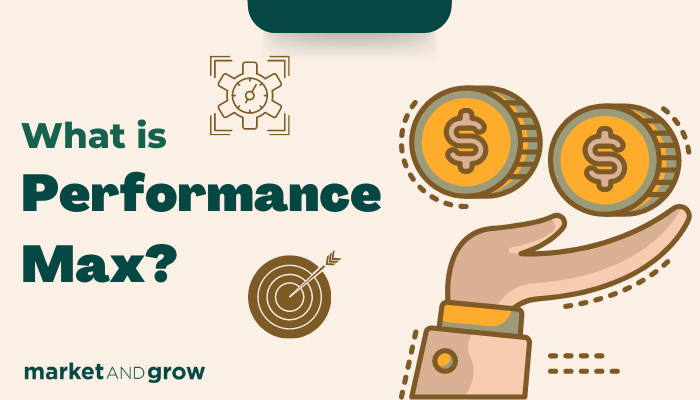
If you ever wondered if you could use automation and machine learning to improve your marketing ROI, Performance Max campaigns are the right fit for you. As the name suggests, this new kind of Google Ads campaign creates a culmination of different automated ads, pushing ad campaigns to their max.
Introduced to Google in 2021, the primary objective of this campaign is generating leads and driving sales without using the Google Merchant Center product feed.
This blog will go into more detail about what Performance Max campaigns are, when you should use them, and how they can help you reach your business goals.
What are Performance Max campaigns?
Google’s Performance Max is a goal-based campaign designed to complement key-based Search campaigns to help businesses find more converting customers across all of Google’s channels, including YouTube, Display, Search, Gmail, and Maps. It utilizes a mix of automation and machine learning to help advertisers execute their specific conversion goals. Basically, Performance Max is your one-stop shop that combines all of Google’s services to focus on one specific goal with a series of assets provided.
Performance Max campaigns combine automation technology across bidding, budget optimization, audiences, creatives, and more. It delivers more conversions and value through the use of Smart Bidding.
If you are familiar with Smart campaigns, it is a similar concept with some tweaks. Also, if you’re familiar with how responsive display ads work, it is taking the mix-and-match option and pulling it into a grander scale.
When to use Performance Max
Performance max is best for advertisers who:
- Access all advertising channels with a single campaign
- Having specific conversion goals, such as driving in-store visits
- Want to maximize campaign performance
- Expand beyond keyword-based search campaigns
If these goals fit what you are looking for, then Performance Max is the right fit for you. Note that it is still in its infancy, and that means when you get down to a micro level, it’s not going to have the same specificity as if you were to run all these ads campaigns separately. However, if you are simply looking for campaign performance as a whole, this is the right fit for you.
What are the Benefits?
Performance Max can help your business in many ways:
- Gain exposure to new audiences across Google: with a real-time understanding of customer intent and audience signals, Performance Max can help discover new customer segments.
- Improve performance across measurable goals: data-driven attribution optimizes for many touchpoints in the customer journey to conversion.
- Unlock more transparent insights: insights such as rising search trends can help advertisers’ broader business strategy and understand which creatives are driving ROI.
- Simplify campaign management through automation: accelerate campaign ramp-up and deliver better results faster.
- Save time: automation frees up time, allowing marketers to focus more on broader strategic decision-making and other high-impact planning.
Sounds enticing, right? Performance Max boosts your goals and saves you time, a pretty lethal combination. In the next section, we’ll let you know a few pitfalls that come with this campaign type.
A few things to keep in mind
Like every Google Ads campaign, Performance Max has its weaknesses. We’re here to give you all the information you need to make an informed decision on whether this campaign is the right choice for your business. Note, these were true before the 2022 Google Marketing Live, stay tuned for our Part 2 in the next blog where we talk about the updates.
Firstly, although you can add multiple asset groups, you cannot report on performance by asset group. According to the Search Engine Journal’s findings, it’s less specific than even what a Display Ads campaign would provide, since you cannot break down the performance by an asset.
Secondly, there is no information on targeting. Since the whole process is automated, Google is constantly doing calculations for your ad that are outside of your knowledge. So if it’s a deal breaker to not know exactly who is seeing your ads, perhaps another of Google’s campaigns would be a better fit.
Conclusion
Performance Max campaigns are part of Google’s effort toward creating automation in advertising. This creates a direct change in what the PPC marketer’s role should look like. It helps to free up time and focus more on a comprehensive strategy and the marketing funnel as a whole, rather than on redundant tasks.
If your budget is less than $10k/day, then Performance Max (or any automation-driven) campaigns are not the right choice for you. Also, Performance Max should not replace your existing search campaigns. It should supplement your Search campaigns. We have seen instances, where cost/conv has increased from $175.54 to $574.45 after the business chose to swap their search campaigns with Performance Max and their budget was small: $300/day. With small budgets, Google’s algorithm does not get enough data points from the auction system to learn quickly and make informed decisions. Meaning, small budgeted advertisers do not win.
Part 2 of this blog will be about the updates that were announced on May 24th, 2022 in Google Marketing Live. Stay tuned on Friday, June 3rd for our new blog.
If this helped clear up what Performance Max can do for your business, consider subscribing to our weekly email newsletter. Simply scroll down to sign up for more helpful marketing information and receive an alert when Part 2 comes out.


